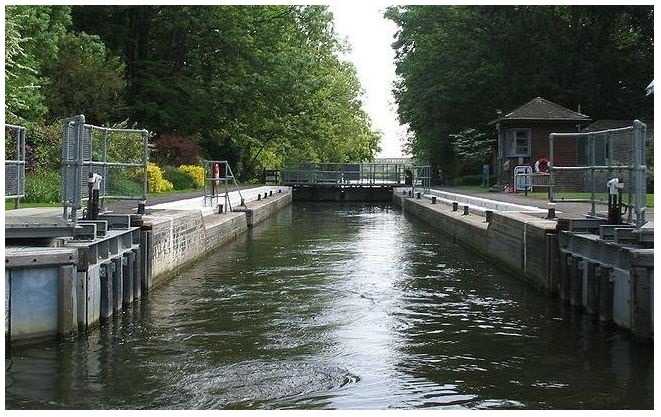Whitchurch Lock

Whitchurch
Lock is one of the 45 locks that enable boats to navigate the length of the
Thames from Teddington to Cricklade.
For the two hundred years to 1787 there was a flash lock
here, requiring boats to be winched up against a rapid flow through a part of
the weir. It was hard work and a
waste of the miller’s water, especially in a dry summer.
Then the Thames Navigation Commissioners built a pound lock in timber,
with two pairs of gates and a fall of about 3 feet.
The ‘Eye Sketch’ below shows the plan for the
pound lock. It is reproduced from
Sir Rickman Godlee’s 1926 book A Village
on the Thames and can be seen enlarged
here. The flash lock is shown
with its winch, towing rope and towpath for horses.
The horses are routed past Thimble Mill and The Swan.

A ‘proposed cut’ upstream, never implemented, can also be
seen. Several small islands are shown.
Passengers took the ferry from the Pangbourne slipway and walked above
the tailrace at the corn mill. The plan
was made in 1786, six years before the first toll bridge opened.
The lock-keeper’s cottage was built in the 1830s and the
lock was rebuilt in brick and stone in 1877.
Hydraulic power for the lock gates was added in 1966.
In Jerome K Jerome’s 1889 comedy novel
Three Men in a Boat the three pass
through Whitchurch lock in their camping skiff, with dog Montmorency, on the way
from London to Oxford. On their
return they abandon their boating holiday at The Swan and catch the London train
from Pangbourne.

Whitchurch
Lock is thought to be the only one of all the Thames locks that is inaccessible
by the public unless they are in a boat. Public
access across the weir from Pangbourne, and from Mill Drive in Whitchurch, was
closed in the 1880s according to Fred Thacker (The
Thames Highway, Volume II, 1920).
Richard Wingfield. August 2014
Photo
taken from the toll bridge: Nick Brazil.